This project, lasting 31 days, gave us the opportunity to display our work and thinking to a much wider audience. I have decided that instead of creating one single reproducible object, I will document my journey of personal development within 31 days, giving a visual diary and tips along the way of how to work with ceramics, in order to encourage other people to attempt similar endeavours.
I started by created these small bowls, simply as a starting point, because I wanted to practice creating a series of objects that were similar shapes but different sizes. I made them by throwing and turning.  They are also stackable, and have a subtle beaded decoration around the lip, they also feature an introverted wide foot ring, something I had not attempted before, but was pleased with the outcome.
They are also stackable, and have a subtle beaded decoration around the lip, they also feature an introverted wide foot ring, something I had not attempted before, but was pleased with the outcome.
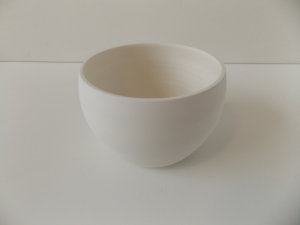
 I then decided to create these three forms. They too are porcelain. When I thought about the form, I deliberately did not think too much, the work you produce often turns out better when its not overthought, and is simple or spontaneous, for me at least. I really did not know my direction, but making these objects would hopefully lead me to further pieces that might lead somewhere.
I then decided to create these three forms. They too are porcelain. When I thought about the form, I deliberately did not think too much, the work you produce often turns out better when its not overthought, and is simple or spontaneous, for me at least. I really did not know my direction, but making these objects would hopefully lead me to further pieces that might lead somewhere. I then began to use architectural clay, thinking more about vessels, which communicate more to me than fully functional objects do. I created a couple of stout vessels by throwing and turning them, here is a link to a video of me centring the clay, a key part in the throwing process. http://www.youtube.com/watch?v=TVbrGonE_pI
I then began to use architectural clay, thinking more about vessels, which communicate more to me than fully functional objects do. I created a couple of stout vessels by throwing and turning them, here is a link to a video of me centring the clay, a key part in the throwing process. http://www.youtube.com/watch?v=TVbrGonE_pI TOP TIPS FOR CENTRING:
TOP TIPS FOR CENTRING:
1) Don’t be shy on the water, chuck that shit on!
2) Take as long as u need, there’s no rush.
3) Make sure its malleable enough to work with.
4) Make sure you have the same amount of water throughout the whole body of clay.
5) Use the speed of the wheel to your advantage by ironing out imperfections.
 Here is a link to a video of me throwing a vessel, it is the second half of the previous video. http://www.youtube.com/watch?v=MWdvjiuSOJA
Here is a link to a video of me throwing a vessel, it is the second half of the previous video. http://www.youtube.com/watch?v=MWdvjiuSOJA TOP TIPS FOR THROWING:
TOP TIPS FOR THROWING:
1) Take it slow, rushing rarely means your controlled.
2) Link your hands to gain a good steady grip.
3) Be patient, it ain’t easy.
4) Compressing will make it rise, this is where the height come from.
5) Practice makes perfect.
Turning is the third stage of the process, in-between drying stages, that can vary very much. Here is a short clip of me turning using a metal kidney. http://www.youtube.com/watch?v=ksbkvdm84Ic
1) Use water to stick the piece down to the wheel.
2) Use sharp tools, to avoid chattering.
3) You always have plenty of clay to work with, don’t fear you will turn too much.
4) Its a chance to re-correct mistakes.
5) Experiment with what you can do in this leather hard state.
I also wanted to keep a fairly open mind for this project, whilst wanting to produce finished pieces, hence I decided to experiment with blindfolded throwing, I also thought it would be a good metaphor for the sense of feeling which is required, more than any other sense. http://www.youtube.com/watch?v=6COlqoDDYXw
TOP TIPS FOR BLINDFOLDED THROWING:
1) It’s a pretty pointless and irrelevant practice.
2) If it boosts your confidence, then why the hell not?
Here is an image of my work after they have been bisque fired. It is possible to stack them in this process as they will not cling together, this means you do have the opportunity to really pack the kiln. A bisque temperature for porcelain is usually around 1000 degrees centigrade, the same for stoneware and also architectural clay in this case. I then began to think about practicing with other clays, in this case terracotta. Its very cheap, and gave me the chance to practice experimenting with mark making.
I then began to think about practicing with other clays, in this case terracotta. Its very cheap, and gave me the chance to practice experimenting with mark making.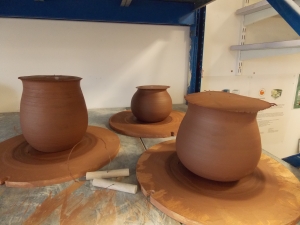 Try to turn over your pieces to allow the bottoms to dry at the same rate, other wise cracking may occur, but not too early otherwise it will loose its shape and collapse.
Try to turn over your pieces to allow the bottoms to dry at the same rate, other wise cracking may occur, but not too early otherwise it will loose its shape and collapse.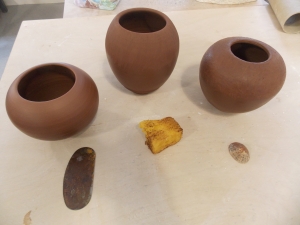 Here I used a sponge, and shell, as well as a metal kidney for burnishing (aligning the clay particles into a smooth surface), here is a video of me turning a design into one of these pieces. http://www.youtube.com/watch?v=P314ljEfN2c
Here I used a sponge, and shell, as well as a metal kidney for burnishing (aligning the clay particles into a smooth surface), here is a video of me turning a design into one of these pieces. http://www.youtube.com/watch?v=P314ljEfN2c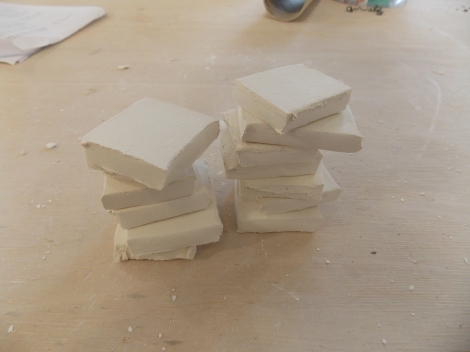 Here is an image of a collection of architectural test tiles, these will be used for experimenting glazes on. Because glaze recipes are often quite hard to absolutely master, or sometimes even control, it is essential to test.
Here is an image of a collection of architectural test tiles, these will be used for experimenting glazes on. Because glaze recipes are often quite hard to absolutely master, or sometimes even control, it is essential to test.  Here is some notes of recipes that I am currently investigating, focusing more on Raku glazes, that feature a lot of High Alkali Frit, which because of its shrinkage capabilities creates distinct crazing that can then be decorated with subsequent smoke firing or ink application.
Here is some notes of recipes that I am currently investigating, focusing more on Raku glazes, that feature a lot of High Alkali Frit, which because of its shrinkage capabilities creates distinct crazing that can then be decorated with subsequent smoke firing or ink application. Here you can see the process of measuring and applying the glazes to bisque ware pieces. There are a number of variables that can dictate the glaze results, size of kiln, temperature of kiln, time spent at the highest temperature (AKA soak period), how the glaze was applied, how quickly the glaze has been put into the kiln since being applied, dust or natural oils from fingers touching the glaze, and many other scientific possibilities that may play a role involving what oxides or clays feature in the glaze.
Here you can see the process of measuring and applying the glazes to bisque ware pieces. There are a number of variables that can dictate the glaze results, size of kiln, temperature of kiln, time spent at the highest temperature (AKA soak period), how the glaze was applied, how quickly the glaze has been put into the kiln since being applied, dust or natural oils from fingers touching the glaze, and many other scientific possibilities that may play a role involving what oxides or clays feature in the glaze. 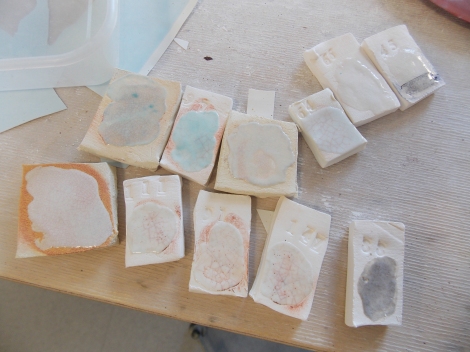
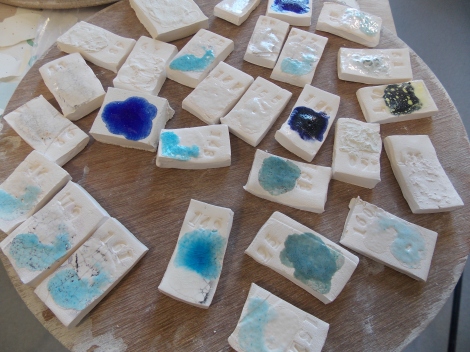
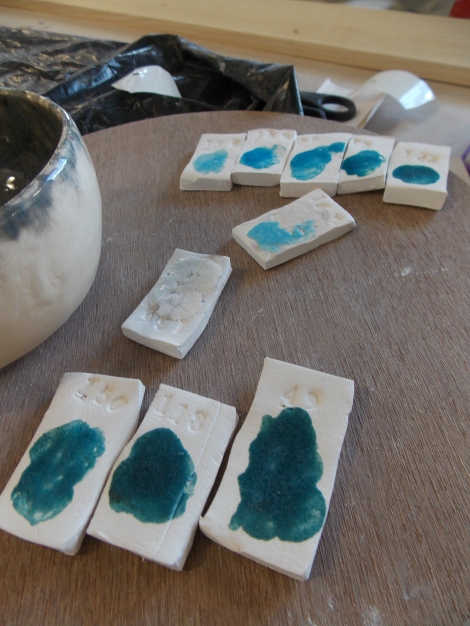
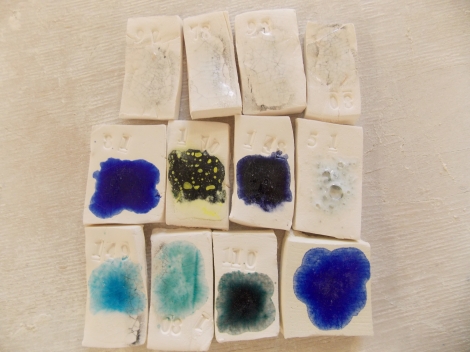 Above are a selection of images that catalogue my personal findings. This particular project I have found it very difficult to replicate specific glazes that I find attractive, this can be problematic because glazing can be a long process.
Above are a selection of images that catalogue my personal findings. This particular project I have found it very difficult to replicate specific glazes that I find attractive, this can be problematic because glazing can be a long process.
TOP TIPS FOR GLAZING:
1) Aim at first to make simple recipes.
2) When you find a glaze that works well, document it, or develop it with further experiments.
3) Be patient, the right glaze is out there.
4) Tyr experimenting with different temperatures with the same glaze.
5) It can be laborious, but often is worth it, with perseverance. Here is one particular glaze that I found interesting, I will attempt to replicate, however it was only created by attempted to salvage something from being a mistake.
Here is one particular glaze that I found interesting, I will attempt to replicate, however it was only created by attempted to salvage something from being a mistake.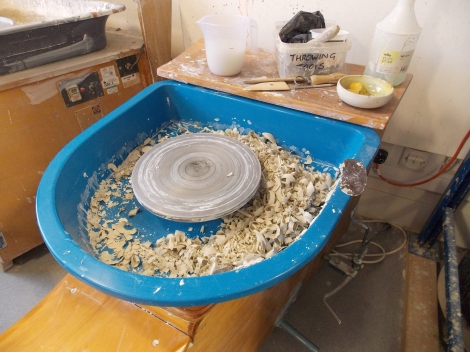 Here is an image of my shavings after the turning process, these shavings can be collected and used as slip, when added to water, or you can attempt to re-claim the clay, by creating a thick slip and letting it dry on plaster board.
Here is an image of my shavings after the turning process, these shavings can be collected and used as slip, when added to water, or you can attempt to re-claim the clay, by creating a thick slip and letting it dry on plaster board.

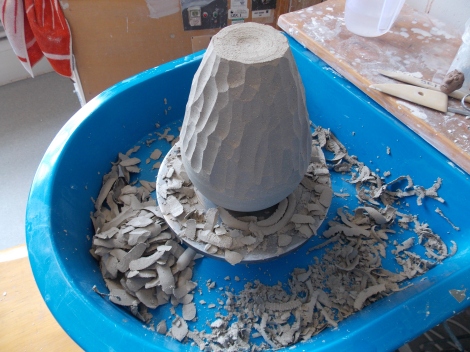 Here I have been in the process of turning an architectural vessel, but half way through decided to experiment by using the metal kidney in a different way, creating a textured carving effect.
Here I have been in the process of turning an architectural vessel, but half way through decided to experiment by using the metal kidney in a different way, creating a textured carving effect.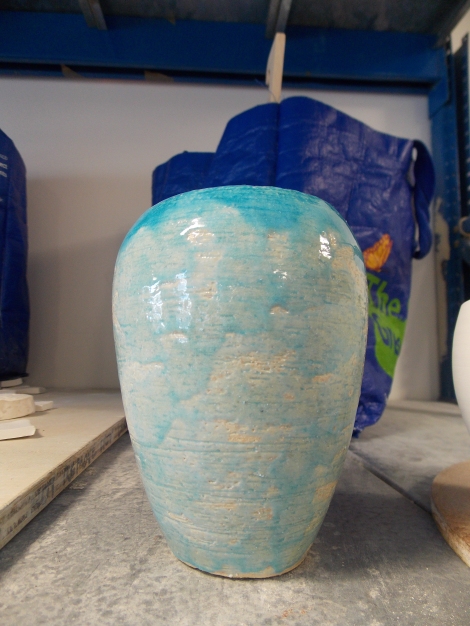 Above is an image of a glaze experiment on a architectural vessel, the result was unexpected and therefore I have decided to smoke fire my architectural pieces, simply because the high alkali frit does not seem to fuse with the architectural pieces very well.
Above is an image of a glaze experiment on a architectural vessel, the result was unexpected and therefore I have decided to smoke fire my architectural pieces, simply because the high alkali frit does not seem to fuse with the architectural pieces very well.
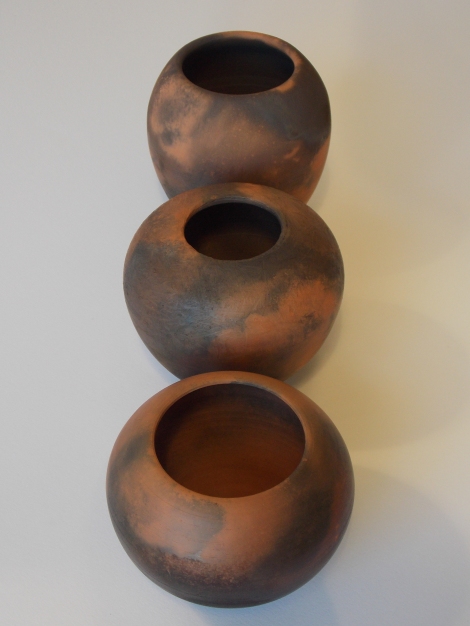
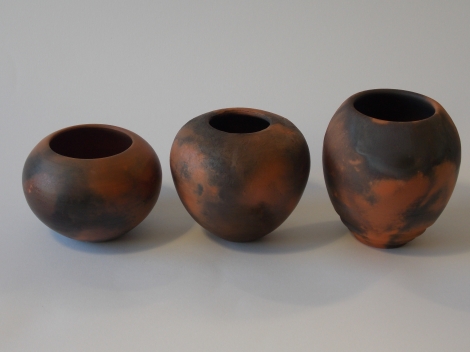 Here are the results of my terracotta smoke firing. Using woodchips, sawdust and straw. I was fairly pleased with these particular results, I felt these pieces needed something on them.
Here are the results of my terracotta smoke firing. Using woodchips, sawdust and straw. I was fairly pleased with these particular results, I felt these pieces needed something on them.

 My architectural vessels that were then smoke fired along with my terracotta pieces turned out pretty well too, I did experiment by applying raw cobalt oxide to them as well as copper carbonate, these traces add subtle qualities of colour.
My architectural vessels that were then smoke fired along with my terracotta pieces turned out pretty well too, I did experiment by applying raw cobalt oxide to them as well as copper carbonate, these traces add subtle qualities of colour.
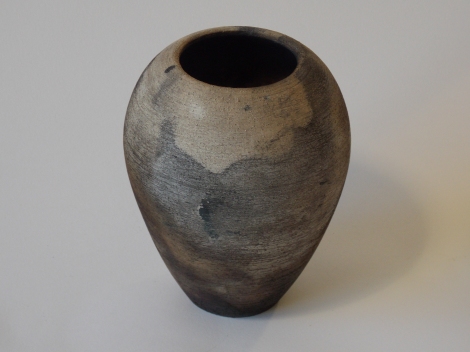



 Below is a porcelain bowl, it is interesting to see how differently the smoke has penetrated the different clay.
Below is a porcelain bowl, it is interesting to see how differently the smoke has penetrated the different clay.
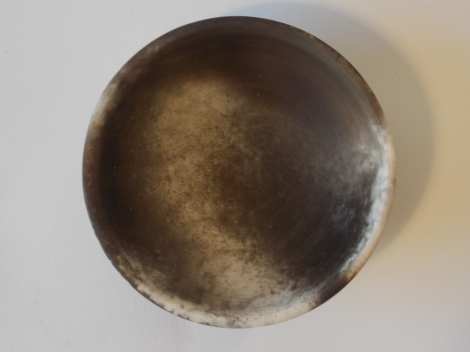 I also put two glazed pieces that I wasn’t too impressed with, I found that the smoke firing did them the world of good.
I also put two glazed pieces that I wasn’t too impressed with, I found that the smoke firing did them the world of good.

 It seems as if the glaze has only partially let the smoke absorb, and helpfully kept its pleasing sheen, these are some of my best results, and have given me more ideas for future trials.
It seems as if the glaze has only partially let the smoke absorb, and helpfully kept its pleasing sheen, these are some of my best results, and have given me more ideas for future trials.


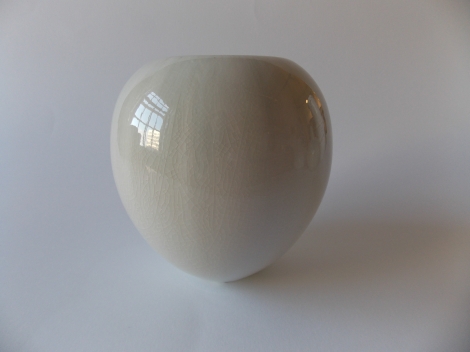 Here are my final pieces, these were porcelain vessels fired at 1260 with a 10 minute soak, the glaze recipe is raku glaze I invented, with a nickel oxide and copper carbonate fade from the peak of the rim.
Here are my final pieces, these were porcelain vessels fired at 1260 with a 10 minute soak, the glaze recipe is raku glaze I invented, with a nickel oxide and copper carbonate fade from the peak of the rim.


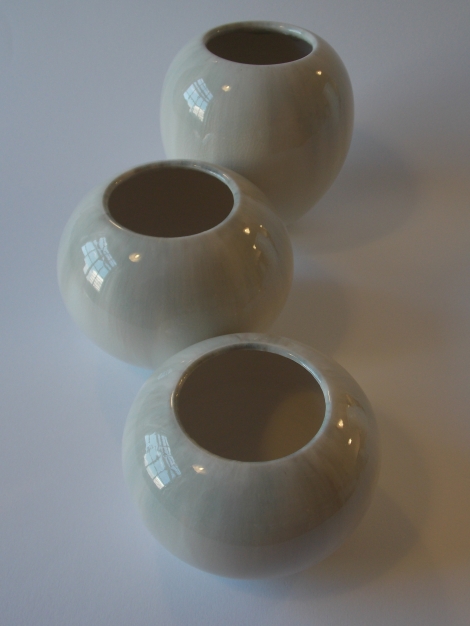
 Overall I was quite happy with them, the crazing is pleasant and the clarity and subtle shades were quite a nice surprise. however the glaze ran too much and stuck the pieces to the kiln shelves, meaning the bottom have large crystallised glaze chunks. As well as the actual porcelain slumping under the extreme heat, destroying the form. They are far from perfect, but they have taught me valuable lessons.
Overall I was quite happy with them, the crazing is pleasant and the clarity and subtle shades were quite a nice surprise. however the glaze ran too much and stuck the pieces to the kiln shelves, meaning the bottom have large crystallised glaze chunks. As well as the actual porcelain slumping under the extreme heat, destroying the form. They are far from perfect, but they have taught me valuable lessons.
TOP TIPS FOR CERAMICS:
1) Your personal happiness is paramount, please yourself.
2) Experiment and try new processes.
3) Be patient and Practice.
4) Embrace the failures, they can spawn new challenges or ideas.
5) Don’t listen to other peoples opinions, it’s not their work.


I read it all now, not just looked at the pictures.
Great work. candid documentation, nice.
Funny as hell sometimes.
Lovely. What porcelain clay are you using?